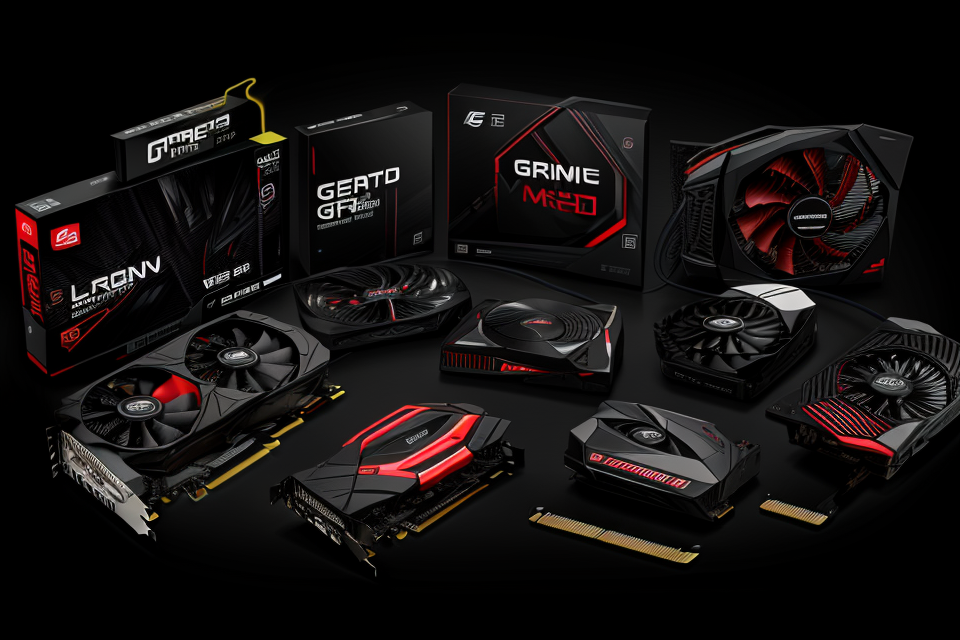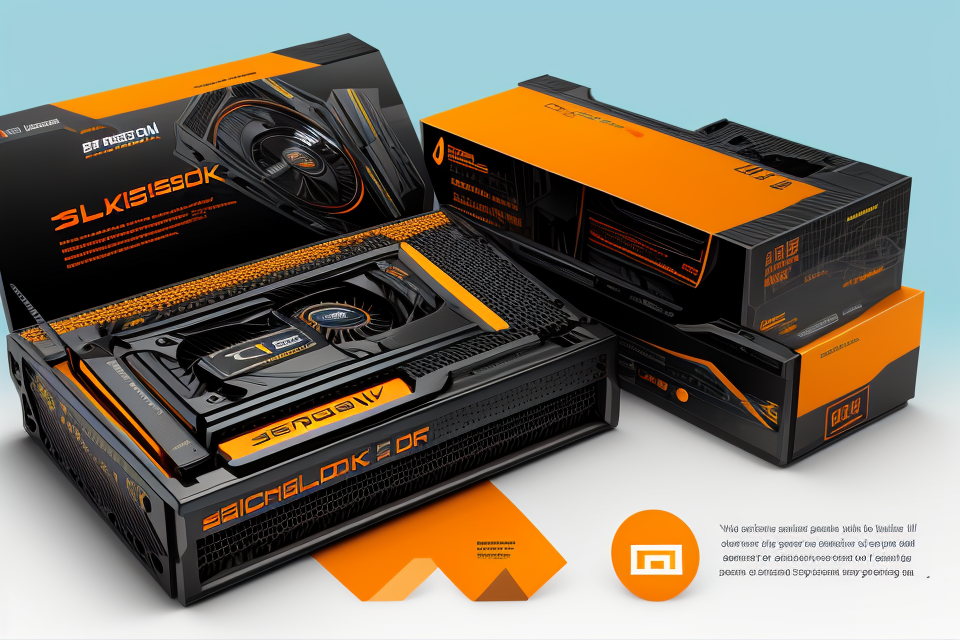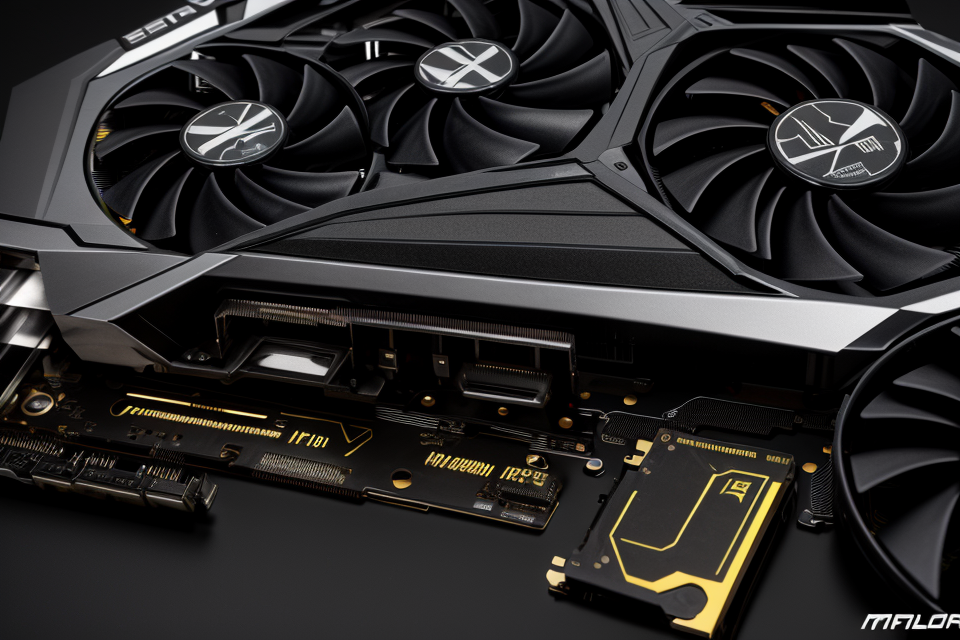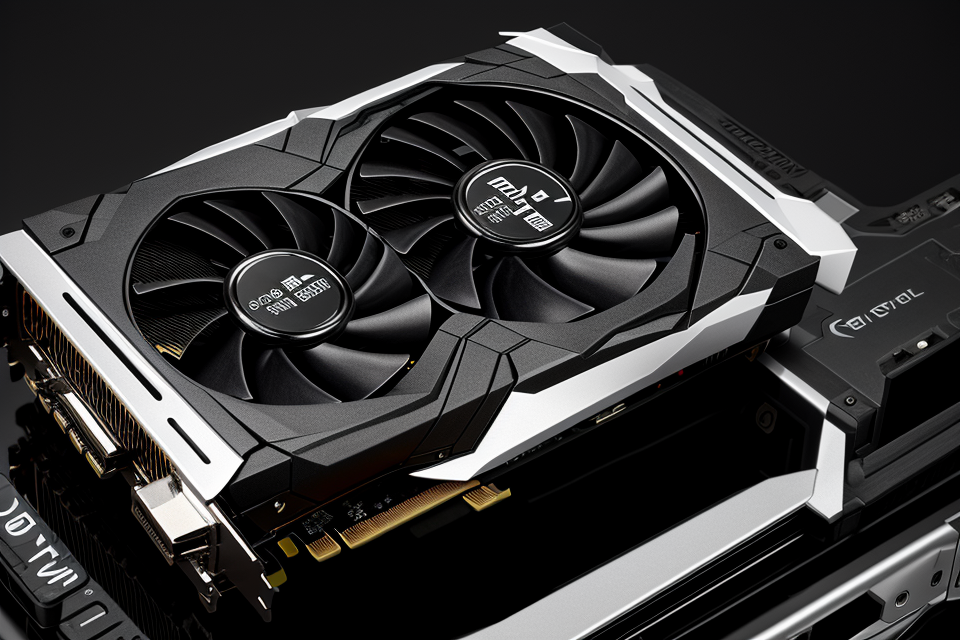
Are you a gamer looking to enhance your gaming experience? Or are you a content creator looking to upgrade your video editing skills? Then you must have come across the term ‘graphics card’. But what exactly is a graphics card? In simple terms, a graphics card is a hardware component that is responsible for rendering images and videos on a computer screen. It is an essential component for any computer that is used for gaming, video editing, or any other graphics-intensive task. In this article, we will delve deeper into the basics of graphics cards and what you need to know before investing in one. So, buckle up and get ready to explore the world of graphics cards!
What is a Graphics Card?
Components of a Graphics Card
A graphics card, also known as a display or video card, is a hardware component that is responsible for rendering images and videos on a computer screen. It is a crucial component in a computer system, particularly for tasks that require intensive graphics processing, such as gaming, video editing, and 3D modeling.
The components of a graphics card include:
- GPU (Graphics Processing Unit): The GPU is the brain of the graphics card, responsible for processing and rendering images and videos. It is designed to handle complex mathematical calculations and can perform multiple tasks simultaneously.
- VRAM (Video Random Access Memory): VRAM is a type of memory that is dedicated to storing images and videos that are being processed by the GPU. It is used to temporarily store data while it is being rendered, allowing the GPU to access it quickly and efficiently.
- CUDA Cores: CUDA cores are small processing units that are found on NVIDIA graphics cards. They are designed to perform complex calculations and are used to speed up the processing of images and videos.
- Memory: Memory is a crucial component of a graphics card, as it is used to store data that is being processed by the GPU. It is available in different types, including GDDR3, GDDR5, and GDDR6, with each type offering different levels of performance and speed.
- Ports: Graphics cards come with a variety of ports, including HDMI, DVI, and DisplayPort, which are used to connect the card to a monitor or TV. These ports allow users to choose the resolution and refresh rate of their display, depending on their needs.
Understanding the components of a graphics card is essential for anyone who wants to build or upgrade their computer system. By selecting the right graphics card, users can improve the performance of their computer and enhance their overall experience when using it for gaming, video editing, or other graphics-intensive tasks.
Differences Between Integrated and Discrete Graphics Cards
Integrated and discrete graphics cards are two primary types of graphics processing units (GPUs) that can be found in computers. Both of these GPUs are responsible for rendering images and videos on a computer screen, but they differ in their performance, power consumption, and cost.
- Integrated Graphics Card: An integrated graphics card is a GPU that is built into the computer’s motherboard or CPU. These cards are less powerful than discrete graphics cards but consume less power and are typically more affordable. Integrated graphics cards are sufficient for basic tasks such as web browsing, video playback, and basic gaming. However, they may not perform well in more demanding tasks such as video editing or high-end gaming.
- Discrete Graphics Card: A discrete graphics card is a GPU that is installed separately from the motherboard or CPU. These cards are more powerful than integrated graphics cards and are designed for tasks that require more graphical processing power. Discrete graphics cards consume more power and are typically more expensive than integrated graphics cards. They are often used for tasks such as gaming, video editing, and other graphically intensive tasks.
In summary, the main differences between integrated and discrete graphics cards are their performance, power consumption, and cost. Integrated graphics cards are less powerful but more affordable and consume less power, while discrete graphics cards are more powerful but consume more power and are more expensive.
Why Do You Need a Graphics Card?
Improved Gaming Performance
A graphics card, also known as a display card or graphics adapter, is an expansion card that is designed to generate images that are displayed on a computer screen. The primary function of a graphics card is to produce high-quality images and to provide enhanced graphics performance. In the context of gaming, a graphics card plays a crucial role in delivering a seamless and immersive gaming experience.
Rendering
Rendering is the process of generating images and animations by applying mathematical algorithms to 3D models. The graphics card is responsible for rendering the images and animations that are displayed on the screen. The more powerful the graphics card, the more complex the images and animations it can render.
Texture Mapping
Texture mapping is the process of applying textures to 3D models to create a more realistic appearance. The graphics card is responsible for texture mapping and can greatly enhance the visual quality of the images that are displayed on the screen.
Anti-Aliasing
Anti-aliasing is a technique used to smooth out the edges of 3D objects and to eliminate the “jagged” appearance that can occur when rendering polygons. The graphics card is responsible for anti-aliasing and can greatly enhance the visual quality of the images that are displayed on the screen.
Shader Processing
Shaders are small programs that run on the graphics card and are used to apply complex effects to the images that are displayed on the screen. The graphics card is responsible for shader processing and can greatly enhance the visual quality of the images that are displayed on the screen.
In summary, a graphics card is essential for gaming because it is responsible for rendering high-quality images and animations, texture mapping, anti-aliasing, and shader processing. A high-performance graphics card can greatly enhance the visual quality of the images that are displayed on the screen and provide an immersive gaming experience.
Enhanced Graphic Design and Video Editing Capabilities
A graphics card, also known as a video card or display card, is an essential component of a computer system that is responsible for rendering images and video on a display device. In this section, we will explore how a graphics card can enhance graphic design and video editing capabilities.
- Rendering Performance:
- Graphics cards are designed to handle complex graphical tasks, such as rendering images and video, which can be resource-intensive.
- By offloading these tasks from the CPU to the GPU, a graphics card can significantly improve rendering performance, allowing for faster and smoother video playback and real-time graphics rendering.
- Image Quality:
- Graphics cards can also enhance the image quality of your graphic design and video editing projects.
- With advanced features such as hardware acceleration, shader processing, and multi-sample anti-aliasing (MSAA), graphics cards can provide higher resolution, smoother edges, and more vibrant colors, resulting in a more realistic and visually appealing final product.
- Advanced Features:
- Graphics cards come with a variety of advanced features that can benefit graphic designers and video editors.
- Some of these features include support for multiple displays, color calibration, and hardware-accelerated decoding and encoding of video formats.
- These features can provide greater flexibility and efficiency in graphic design and video editing workflows, enabling users to work with larger and more complex projects, and streamline the editing process.
Overall, a graphics card can significantly enhance the graphic design and video editing capabilities of a computer system, providing faster rendering performance, higher image quality, and advanced features that can streamline workflows and increase productivity.
Increased Efficiency in Other Applications
Graphics cards, also known as video cards or display adapters, are hardware components designed to handle the visual output of a computer. While they are primarily used for gaming and other graphics-intensive applications, they can also provide benefits in other areas of computing.
One of the primary advantages of having a graphics card is increased efficiency in other applications. Many tasks that are not related to graphics can still benefit from the processing power of a graphics card. For example, video encoding and decoding, scientific simulations, and data analysis can all be accelerated by a dedicated graphics card.
Some of the most popular applications that can benefit from a graphics card include:
- Video Editing: Video editing software can take advantage of the parallel processing capabilities of a graphics card to speed up the rendering process. This can be especially useful for professionals who work with large amounts of video footage.
- 3D Modeling: 3D modeling software can use the power of a graphics card to accelerate the creation and manipulation of complex 3D models. This can be particularly useful for architects, engineers, and game developers.
- Scientific Simulations: Scientific simulations, such as weather modeling or fluid dynamics, can be computationally intensive. A dedicated graphics card can help speed up these simulations, allowing researchers to run more complex models in less time.
In summary, a graphics card can provide benefits beyond just gaming and graphics-intensive applications. It can help increase efficiency in a wide range of tasks, from video editing to scientific simulations. If you are looking to improve the performance of your computer, a graphics card may be a worthwhile investment.
Types of Graphics Cards
Integrated Graphics Cards
Integrated graphics cards are an integral part of a computer’s motherboard or CPU. They share the same memory as the computer’s RAM and are not dedicated to graphics processing like discrete graphics cards. They are commonly found in laptops, all-in-one computers, and some low-end desktop computers. Integrated graphics cards are useful for basic tasks such as web browsing, video playback, and basic gaming. However, they may not be powerful enough for more demanding tasks such as gaming or graphic design.
Discrete Graphics Cards
Discrete graphics cards, also known as add-in graphics cards, are separate graphics processing units (GPUs) that can be installed in a computer’s PCIe expansion slot. These graphics cards are designed to offload the graphics processing workload from the CPU, providing better performance and smoother graphics in demanding applications such as gaming, video editing, and 3D modeling.
Some key features of discrete graphics cards include:
- Higher performance: Discrete graphics cards are designed specifically for graphics processing, and they typically offer higher performance than integrated graphics solutions found in most CPUs.
- Flexibility: Discrete graphics cards can be installed or removed as needed, allowing users to upgrade or downgrade their graphics capabilities based on their needs.
- Compatibility: Discrete graphics cards are compatible with a wide range of computers, including desktops and laptops, and they can be used with a variety of operating systems, including Windows, macOS, and Linux.
There are many different discrete graphics card options available on the market, ranging from budget-friendly options to high-end models designed for demanding applications. Some popular brands of discrete graphics cards include NVIDIA and AMD.
Dedicated Graphics Cards
Dedicated graphics cards, also known as discrete graphics cards, are standalone graphics processing units (GPUs) designed specifically for handling graphical tasks. These cards are not integrated into the motherboard and require a PCIe slot for installation. They are particularly useful for individuals who engage in activities that require high levels of graphics processing power, such as gaming, video editing, and 3D modeling.
There are several key features to consider when selecting a dedicated graphics card:
- Performance: The most important factor to consider when selecting a dedicated graphics card is its performance. Higher-end cards typically offer better performance and can handle more demanding tasks.
- Memory: The amount of memory a dedicated graphics card has can also impact its performance. Cards with more memory can handle larger datasets and more complex graphics.
- Power consumption: Dedicated graphics cards require additional power to operate, so it’s important to ensure that your power supply can handle the card’s power requirements.
- Compatibility: Make sure the dedicated graphics card is compatible with your computer’s motherboard and power supply.
Dedicated graphics cards are available from a variety of manufacturers, including NVIDIA and AMD. It’s important to research and compare different models to find the one that best meets your needs and budget.
How to Choose the Right Graphics Card for Your Needs
Determine Your Budget
When it comes to choosing the right graphics card for your needs, determining your budget is an essential first step. This is because the price of graphics cards can vary widely, and you’ll want to make sure that you choose a card that fits within your budget without sacrificing too many features or performance.
Here are some factors to consider when determining your budget for a graphics card:
- Your overall system budget: The price of a graphics card is just one component of your overall system budget. Make sure to consider the cost of other components like the CPU, motherboard, and RAM as well.
- The specific use case: The type of games or applications you plan to use with your graphics card can impact the price. For example, high-end gaming cards may be necessary for demanding games like first-person shooters or racing simulators, while more basic cards may be sufficient for casual gaming or everyday tasks.
- Your performance requirements: If you’re a competitive gamer or content creator, you may require a graphics card with high performance and advanced features. However, if you’re using your computer for basic tasks like browsing the web or watching movies, a more basic card may be sufficient.
Overall, determining your budget is a crucial step in choosing the right graphics card for your needs. By considering your overall system budget, specific use case, and performance requirements, you can narrow down your options and find a card that fits within your budget without sacrificing too many features or performance.
Assess Your Performance Needs
Choosing the right graphics card is crucial for optimizing your computer’s performance. Before making a purchase, it is essential to assess your performance needs. This involves considering several factors, including the type of tasks you perform, the software you use, and the hardware specifications of your computer.
To begin, you should identify the type of tasks you perform on your computer. For example, if you are a gamer, you will require a graphics card that can handle demanding games with high-quality graphics. On the other hand, if you are a professional who uses computer-aided design (CAD) software, you will need a graphics card that can handle complex 3D models and rendering.
Next, consider the software you use. Some software applications are more demanding than others, and may require a more powerful graphics card to run smoothly. For instance, video editing software and graphic design programs can be resource-intensive and may require a higher-end graphics card.
Additionally, you should consider the hardware specifications of your computer. The graphics card you choose should be compatible with your computer’s motherboard and power supply unit (PSU). It is also important to ensure that your computer’s case can accommodate the graphics card you choose, as some graphics cards can be quite large.
In summary, assessing your performance needs is an essential step in choosing the right graphics card. By considering the type of tasks you perform, the software you use, and the hardware specifications of your computer, you can make an informed decision and choose a graphics card that meets your needs.
Consider the Brand and Model
When it comes to choosing the right graphics card for your needs, one of the most important factors to consider is the brand and model. While there are many different brands and models of graphics cards on the market, some are better suited for certain types of applications than others. Here are a few things to keep in mind when considering the brand and model of your graphics card:
- Brand Reputation: Some brands are known for producing high-quality graphics cards that offer excellent performance and reliability. Brands like NVIDIA and AMD are well-established in the market and have a reputation for producing top-performing graphics cards. Other brands, such as Intel, may be less well-known in the graphics card market but still offer quality products.
- Model Features: Different models of graphics cards come with different features and capabilities. For example, some models may be better suited for gaming, while others may be better for professional applications like video editing or 3D modeling. When choosing a graphics card, it’s important to consider the specific features and capabilities that are most important for your needs.
- Performance: Another important factor to consider is the performance of the graphics card. Different models will offer different levels of performance, so it’s important to choose a card that can handle the types of applications you’ll be using it for. Some models may offer more advanced features like real-time ray tracing or AI-accelerated rendering, which can greatly enhance the performance of certain types of applications.
- Price: Finally, it’s important to consider the price of the graphics card. While high-end models can offer excellent performance, they can also come with a hefty price tag. It’s important to choose a card that fits within your budget while still meeting your performance needs.
Overall, choosing the right brand and model of graphics card is crucial for ensuring that you get the best performance and reliability for your needs. By considering factors like brand reputation, model features, performance, and price, you can make an informed decision that will help you get the most out of your graphics card.
Look for Reviews and Compare Specs
When it comes to choosing the right graphics card for your needs, one of the most important things you can do is to look for reviews and compare specs. This will help you make an informed decision about which graphics card is best for your particular needs.
Here are some specific tips for looking for reviews and comparing specs:
- Look for reviews from reputable sources: When reading reviews, it’s important to make sure that the source is reputable and knowledgeable about graphics cards. Some good sources for graphics card reviews include Tom’s Hardware, TechRadar, and AnandTech.
- Pay attention to benchmarks: Benchmarks are tests that measure the performance of a graphics card in different scenarios. They can be a good way to compare the performance of different graphics cards, especially if you’re planning to use the card for gaming or other graphics-intensive tasks.
- Compare specs: Make sure to compare the specs of different graphics cards to see which one is the best fit for your needs. Some important specs to consider include the number of CUDA cores, memory size, and clock speed.
- Consider your budget: Graphics cards can vary widely in price, so it’s important to consider your budget when making a decision. Keep in mind that a higher price doesn’t always mean a better card – it’s important to balance price with performance to find the best value for your money.
Overall, taking the time to look for reviews and compare specs can help you make a more informed decision when choosing a graphics card. By doing your research, you can find a card that meets your needs and budget, and that will help you get the most out of your gaming or other graphics-intensive applications.
Future Developments in Graphics Cards Technology
Improved Performance and Efficiency
One of the main areas of focus for future developments in graphics cards technology is improving performance and efficiency. This includes developing more powerful and efficient GPUs that can handle the demands of modern games and other graphics-intensive applications. Additionally, manufacturers are exploring new materials and cooling technologies to help reduce the heat output of graphics cards and improve their overall lifespan.
Virtual Reality and Augmented Reality Support
Another area of focus for future graphics card development is support for virtual reality (VR) and augmented reality (AR) applications. As these technologies become more prevalent, graphics cards will need to be able to handle the increased processing demands of VR and AR experiences. This includes not only rendering high-quality graphics, but also tracking head movements and providing a smooth, responsive experience for users.
Artificial Intelligence and Machine Learning
Artificial intelligence (AI) and machine learning (ML) are also expected to play a major role in future graphics card technology. As these technologies become more advanced, they will require increasingly powerful graphics processing capabilities. Graphics cards that are optimized for AI and ML workloads will be able to provide the necessary performance to support these applications.
3D and 4D Graphics
As 3D and 4D graphics technology continues to evolve, graphics cards will need to be able to handle the increased demands of these applications. This includes not only rendering complex 3D models, but also adding depth and interactivity to 4D experiences. Future graphics cards will need to be able to handle these demands in order to provide a truly immersive experience for users.
Other Developments
Other potential developments in graphics card technology include improved display technologies, such as higher resolutions and faster refresh rates, as well as improved connectivity options, such as support for Thunderbolt 3 and USB Type-C. Additionally, manufacturers may explore new form factors and designs for graphics cards, such as smaller, more compact models that are easier to install and upgrade.
FAQs
1. What is a graphics card?
A graphics card, also known as a video card or display card, is a hardware component that is responsible for rendering images and videos on a computer screen. It is an essential component for gaming, video editing, and other graphics-intensive applications.
2. What does a graphics card do?
A graphics card processes and renders images and videos that are displayed on a computer screen. It performs complex calculations to transform the data from the computer’s memory into the images and videos that we see on the screen. The graphics card also handles the output of the data to the display, controlling the resolution, color depth, and refresh rate of the screen.
3. What are the different types of graphics cards?
There are two main types of graphics cards: integrated and discrete. Integrated graphics cards are built into the motherboard and share memory with the CPU, while discrete graphics cards are separate components that have their own memory and are installed in a PCIe slot. Discrete graphics cards are generally more powerful and can handle more demanding tasks.
4. How do I know if my computer has a graphics card?
You can check if your computer has a graphics card by looking at the specifications of your computer or by opening the case of your computer and checking if there is a separate graphics card installed. If your computer has an integrated graphics card, it will be listed in the specifications under the name of the CPU.
5. How do I choose a graphics card?
When choosing a graphics card, consider the type of tasks you will be using it for. If you plan to use it for gaming or video editing, a discrete graphics card with a high level of performance will be necessary. You should also consider the amount of memory the graphics card has, as well as its compatibility with your computer’s motherboard and power supply.
6. How do I install a graphics card?
Installing a graphics card involves removing the side panel of your computer’s case, removing the old graphics card (if applicable), and inserting the new graphics card into the PCIe slot. You will then need to connect the graphics card to the power supply and attach any necessary cables. Finally, you will need to install the graphics card’s drivers and software.


